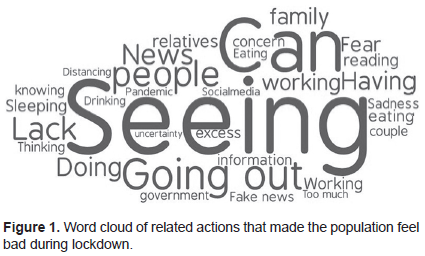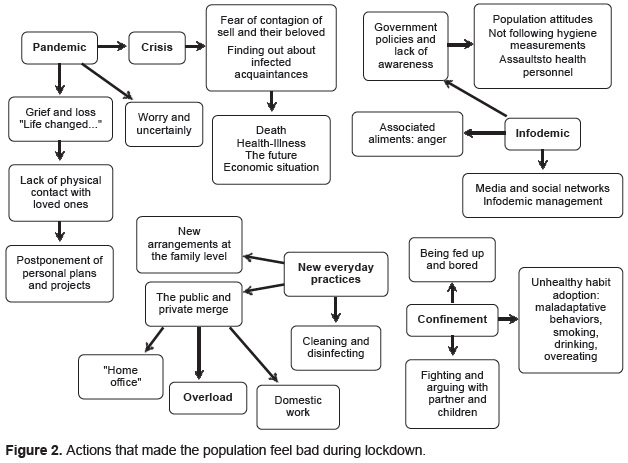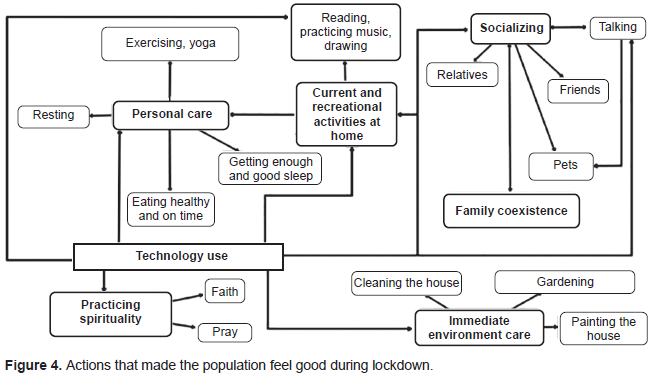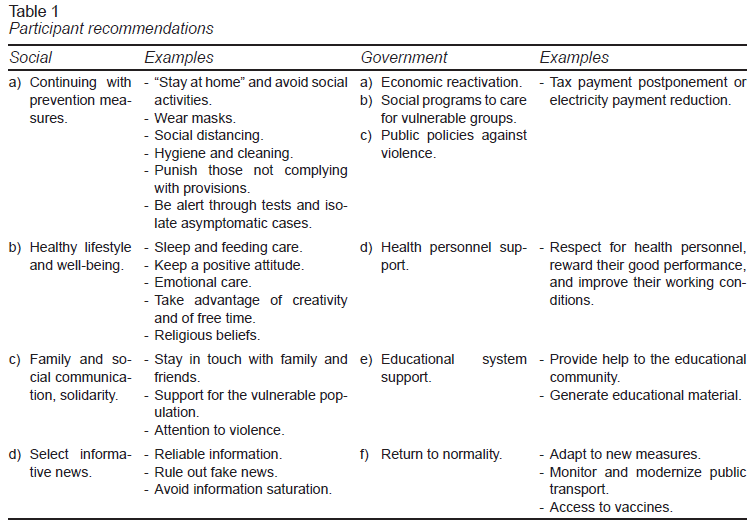INTRODUCTION
Due to the spread of the disease caused by coronavirus SARS-CoV-2, which had caused 2,667,000 deaths worldwide by mid-March 2021, governments have recommended sheltering in place (WHO, 2020). On March 24, 2020, the Mexican government decreed the suspension of certain activities, recommending that the general population should stay home. Research has documented both positive and negative experiences related to lockdown (Matrajt & Leung, 2020). A study conducted in Spain identified the negative experiences that predominated in women and youth (19-30 years old), including fear of infection, exposure to the media, and living with chronic patients. The main positive experiences were interpersonal relationships, time spent with the family, religious or spiritual practices, and interest in helping other people (Sandín, Valiente, García-Escalera, & Chorot, 2020). Lockdown has been found to produce anger, boredom, frustration, and insomnia, and can even persist when distancing measures have eased (Brooks et al., 2020).
It has been observed that stress, anxiety, depression, worry, and uncertainty are common in these types of circumstances (Rehman et al., 2021; Usher, Durkin, & Bhullar, 2020). Other sources that create discomfort are living in a small space, since this limits physical activity (Bravo-Cucci, Kosakowski, Núñez-Cortéz, Sánchez-Huamash, & Ascarruz-Asencios, 2020; Parrado-González & León-Jariego, 2020; Rodríguez-Rey, Garrido-Hernansaiz, & Collado, 2020). In addition, it can affect interpersonal relationships during daily coexistence, especially if people spend a lot of time living under these conditions (Douglas, Katikireddi, Taulbut, McKee, & McCartney, 2020). Stressors such as emotional distress derived from perceived stress and internalized symptoms that emerge during prolonged lockdown appear to persist beyond lockdown (Petzold et al., 2020).
Other effects on health involve disrupted sleep patterns (Altena et al., 2020; Cellini, Canale, Mioni, & Costa, 2020) and eating habits (Bhutani & Cooper, 2020). Together, these factors can lead to chronic fatigue syndrome (Majumdar, Biswas, & Sahu, 2020). In short, physical distancing has implications both for people’s individual and the collective health (Smith, Ng, & Li, 2020; Pfefferbaum & North, 2020).
In this work, emotional well-being refers to the emotional quality of an individual’s daily experience: the frequency and intensity of experiences of joy, stress, sadness, anger, and affection that make life pleasant or unpleasant; it is influenced by various demographic, economic and situational factors (Kahneman & Deaton, 2010). Discomfort is a “subjective feeling of suffering, it is the lack of response to a prolonged stress situation, which is recorded as a personal inability to cope with the situation” (Burín, 1990, p. 35).
Multiple studies that have included the general population have pointed out the implications of the pandemic. People affected include those with by who have a respiratory syndrome (Pfefferbaum & North, 2020; Sandín et al., 2020; Parrado-González & León-Jariego, 2020; Rodríguez-Rey et al., 2020), health professionals (Brooks et al., 2020; Pfefferbaum & North, 2020; Usher et al., 2020), as well as groups from the business sector, homebound workers, and university students (Majumdar et al., 2020; Cellini et al., 2020). In Mexico, an extensive study was conducted on emotions and coping responses to the COVID-19 pandemic in the Mexican population (Ramos-Lira et al., 2020). This paper, which is more qualitative in nature, is based on that research.
METHOD
An online survey was designed by a group of researchers with experience in the mental health field, using the virtual platform QuestionPro (2020) to explore the impact of the pandemic on the adult population in Mexico during the first lockdown period.
Methodological aspects can be consulted in another article (Ramos-Lira et al., 2020).
Participants
The sample comprised 2,555 participants: 78.3% women and 21.7% men, with an average age of 46.2 ± 13.80; 48.7% had a partner, and 35.5% reported being single. Most participants held a bachelor’s degree (49%), 31% a graduate degree, and 12.1% had completed high school, while the rest had completed junior high school or less. A total of 45.3% reported being employed and 7.8% reported having lost their jobs. Finally, men were the breadwinners in 60% of cases and women in 30%. In 10% of cases, subjects reported that they obtained their income through the support of family/friends, government aid programs, or scholarships (Ramos-Lira et al., 2020).
The survey contained 25 questions on measures to reduce contagion, verbal and physical attacks on health personnel, experiences during the pandemic, coping strategies, and three open questions, which were qualitatively analyzed for this article: 1. Mention three actions that have made you feel bad or have not helped you during lockdown, 2. Mention three actions that have helped you feel good during lockdown, and, 3. What positive actions would you suggest for coping with the pandemic?
Lexicometric analysis and categorization
Due to the breadth of responses obtained in the survey (n = 2,555), two types of analysis were conducted. The first was a lexicometric analysis using the word cloud resource, based on: “The multidimensional descriptive analysis from which a vocabulary and a cloud of frequent words is obtained representing the context of the language” (Barreto, Velandia-Morales, & Rincón Vázquez, 2011). This is a textual analysis method that forms part of the tradition of the development of statistical techniques applied to linguistic or discursive data analysis pioneered by Benzécri (1982). The QuestionPro (2020) program allowed the generation of a conceptual map for the identification of words, categories, and thematic units.
Additionally, a thematic analysis was undertaken with the participation of the first three authors of this paper, who reviewed individually the answers to each of the questions and subsequently held virtual meetings to jointly analyze the categories identified to reach a consensus. The context of the answers provided by the subjects was obtained through QDAMiner 4.1.2, which facilitated the organization of the information (Chomczynski, 2008).
Ethical considerations
The study was previously reviewed and approved by the Research Ethics Committee of the Ramón de la Fuente Muñiz National Institute of Psychiatry (Instituto Nacional de Psiquiatría Ramón de la Fuente Muñiz, INPRFM). The survey was conducted from June 3 to July 5, 2020. As part of the ethical considerations, a directory was provided for people seeking mental health care.
RESULTS
Activities related to discomfort
“Life changed”
In the word cloud (Figure 1), the words most frequently mentioned by subjects were: seeing (655), being able to (479), people (333), and going out (331). They are all interrelated and expressed the way life changed during lockdown and the feeling of a lack of control due to being limited, as well as the difficulty of having face-to-face contact with other people (See/not see): “Not being able to see friends and family,” “not being able to go out freely ...” Subjects were also upset by seeing people who do not do the right thing, follow safety measures, and who fail to wear mouth covers, or adopt other practices, suggesting they do not believe the virus exists, which in turn causes a risk of infection; in essence “Seeing people who do not follow the norms.” It should be noted that only 1.9% reported not having experienced any discomfort during confinement.
Categories linked to discomfort
Figure 2 shows the categories analyzed considering the context of the responses. As can be seen, the pandemic represents a crisis whose repercussions have been traumatic for some people due to the drastic change it has caused in their life dynamics. A central category in this experience is fear, both of becoming infected and of infecting one’s loved ones and the implicit concern about the high risk of death, coupled with the uncertainty associated with the economic situation and the future in relation to work, both in those who had a job and those who did not, such as “Worrying someone in my family will lose his/her job,” “That people will be out of work,” “That I have not been able to get a job.” This is a sample of the experiences that were lived both individually and collectively.
Factors that created the greatest discomfort and concern included the loss of physical contact with loved ones, family, and friends, examples of which include not being able to spend time together or interact and physical and emotional distancing (such as being unable to hug or kiss). This was even more difficult when there was a person with a health problem that required special care (such as children and older adults). A more specific subcategory was also included here which concerns solidarity and empathy towards others putting people in such situations that they felt they were “not being able to help other people,” which created a feeling of helplessness and frustration. Subjects also mentioned not being able to engage in the activities they used to enjoy before the pandemic (such as exercising, running outdoors, going to the gym, and frequenting public spaces).
As expressed in the responses analyzed, being confined due to lockdown caused significant stress in the population during this first stage. For example, overexposure to the news, watching television or violent or sad series, oversaturation of information on the pandemic in social networks (numbers of deaths), finding out about acquaintances with COVID-19, financial difficulties, violence and insecurity, unemployed people, fake news in social networks and the media, price increases, perception of an inconsistent attitude by the government towards the pandemic, as well as attacks on health personnel made subjects angry. Other implications were related to the adoption of unhealthy habits such as overeating, sleep disturbances, and neglecting personal hygiene.
Finally, public and private spheres came together in the domestic space, creating disorganization and altering daily routines which involved coping with everyday stress and the distress of not being able to complete, or only partially complete pending tasks. Although electronic devices were a resource for not stopping work activities, they also produced high levels of stress and enormous pressure linked to the fear of losing a job and the attendant consequences as borne out by the following responses: ”Working too much, virtual work meetings and being under pressure,” "The bosses have given me lots of work outside my usual hours,” “When I have been working from home, I have worked up to twelve hours a day,” “I have a lot of work online, I am a teacher and I get very stressed, because I rely on the Internet, the computer, electricity, kids being able to connect and so on ...” and, “I don’t feel comfortable doing my work (computer) at home.”
The pandemic has signified the loss of daily routines and social interaction with loved ones and the deferral of personal plans and projects. People have had to come up with new arrangements, new daily practices, the public and the private have merged, and work and family life have been modified by the use of technology. As noted earlier, the survey subjects are a predominantly female population with high levels of educational attainment and employment with only 14% reporting exclusively engaging in housework.
In this respect, great distress is caused by the overload of work activities combined with domestic chores such as grocery shopping, making meals, disinfection, and housework. Other burdens are the care and attention of other family members, prescholers, adolescents, and older adults without having extra support for schoolwork, and providing medical care for close relatives who require it.
However, as we will see below in more detail, at the beginning of the pandemic most people regarded lockdown positively since it was a great opportunity to be closer to the family, share meals, and spend more time together, while dealing with an adverse situation.
Feeling privileged in relation to other vulnerable groups
Activities related to well-being
From the point of view of the subjects, lockdown involved positive experiences as observed in the word cloud (Figure 3). The most frequently mentioned words in the responses were: doing, exercising, family, being and reading. Home and family life had the highest frequency of replies.
Categories related to well-being
As can be seen in Figure 4, the main categories identified by consensus among the research team, which considers the context of the responses, concern individual and family dynamics. At the individual level, this includes personal care, associated with exercising, resting, healthy eating, and sleep hygiene (such as “doing exercise and eating well, resting and sleeping well”). Personal care included intellectual and recreational activities, such as: “reading things that interest me,” “listening to classical music,” “watching movies, series,” “dancing,” “playing an instrument and singing.” Other resources included spiritual and religious activities such as “praying and promoting prayer,” “meditating and doing yoga helps a lot”, and “I try to seek spiritual support through electronic means.”
Other reported activities involved taking care of the environment, the house, and common areas. Lockdown provided an opportunity for doing tasks which people usually do not have time for such as home repairs and improvements, “fixing and cleaning my house,” and “doing gardening.”
Eating together as a family was more appreciated, “We spend more time together as a family, which has allowed us to talk to each other more,” and “Being able to enjoy my family by doing things together.” Despite the difficulties of virtual meetings, they proved to be a useful resource for many families and helped them keep in touch with their loved ones. It is important to note, however, that 1.49% of the responses involved family conflicts and violence.
The most highly valued aspects were having a job alongside the digital and technological resources to be able to continue activities from home. Technology therefore played a central role. Only .3% of subjects said that nothing had made them feel good during confinement.
Suggestions and recommendations by subjects to mitigate the effects of the pandemic
Table 1 summarizes the measures suggested by subjects to deal with the pandemic which mainly target the government and society. Subjects are divided regarding the public policies adopted by the federal government. Some criticize the decisions of the government during the pandemic while others defend these measures and approve of its recommendations. Six dimensions were associated with the government, those being reactivation of the economy, social programs to care for vulnerable groups, public policies against violence, support for health personnel as well as for the educational system, and the return to normality. Finally, solidarity and mutual support became important for strengthening community support networks, especially to maintain interpersonal closeness with family members, friends, and vulnerable groups living in violent situations.
DISCUSSION AND CONCLUSION
Findings of this survey reveal the emotional effects of the first COVID-19 lockdown in Mexico which has involved dealing with certain challenges people face in their daily lives expressed at the individual, family, and community level. Analysis of the negative and positive experiences reported by study subjects shows that discomfort was not only related to uncertainty about the possibility of being infected by the virus, losing their lives, or experiencing the death of loved ones, but also involved the loss of social interaction and adjusting to a new scenario in daily life in which the public and the private merged. The most representative experiences of well-being involved learning from the pandemic. Subjects mentioned the possibility of sharing family activities and undertaking projects and personal plans they had previously been unable to implement for a variety of reasons.
However, as time went by, due to the absence of fixed schedules, what was initially valued as the possibility of coinciding and sharing with the family segued into other problems, such as a sedentary lifestyle, poor health, and disrupted sleep and eating habits. At the same time, lockdown and sharing the same space for a long time had implications for family relationships, triggering conflicts over having a place to carry out academic and work activities. Adapting to technological resources was a major challenge since it required having equipment that was usually shared with other family members without having digital services for support which sometimes led to arguments and violence between family members. All this translated into discomfort for the subjects expressed as concern, fear, anger, “wanting to scream” and loneliness. These findings coincide with what has been reported in other studies on actions concerning discomfort and well-being because of lockdown (Brooks et al., 2020; Rodríguez-Rey et al., 2020; Pfefferbaum & North, 2020; Sandín et al., 2020).
The effects of the pandemic on the population have highlighted another problem linked to social inequality. It has been found that social groups with greater economic, material, and technological resources can remain under lockdown for long periods of time as borne out by the answers of the subjects, mostly women with a higher level of educational attainment and human resources and materials. They experienced lockdown positively and appreciated having a job and the resources that enabled them to experience it with some peace of mind. Furthermore, an altruistic dimension was observed in the responses through phrases expressing concern for vulnerable population groups that lacked employment and minimal subsistence conditions.
It has now been acknowledged that the pandemic has shone a spotlight on social inequality, including gender inequities. In this regard, it is important to note that 70% of the answers came from women who reported more experiences related to the emotional discomfort associated with the double and triple shift associated with house cleaning, disinfecting groceries, caring, and providing school support for children, conflicts with their partner, looking after people with some form of physical or mental condition, and caring for elderly adults in addition to the remote work they had to perform.
Study limitations and contributions
It is not possible to generalize the findings to the general population in Mexico because the study was not representative. At the same time, due to the exploratory and qualitative nature of the study, no comparisons were made based on the sociodemographic characteristics of the subjects.
One of the contributions of this research was the methodological triangulation achieved by having a lexicographic analysis undertaken by someone other than the researcher, performing a thematic analysis of the context of responses the subjects at the individual level, and reaching consensus, through virtual meetings, to determine the meaning of the answers within a context beyond the frequency of the words used. However, lexicographic analysis is also useful especially when there are large samples, as in the case of online surveys. These findings can be enhanced by a more detailed thematic analysis.
In short, global studies documenting the consequences of lockdown and isolation of the population and those around them due to the pandemic (Brooks et al., 2020; Douglas et al., 2020; Smith et al., 2020; Pfefferbaum & North, 2020) are crucial for designing health policies and programs to address the psychosocial and health effects of pandemics (Holmes et al., 2020). This poses a challenge because pandemic disasters are unique and scientific research on the impact on mental health of the combination of a pandemic with prolonged isolation is limited (Galea, Merchant, & Lurie, 2020). Strategies are therefore required to guarantee the overall health needs of families. Collaboration between different population groups, government agencies, civil society, and NGOs are also needed to mount an organized response to mitigate the consequences of social confinement. In addition, follow-up studies are essential to furthering knowledge on the implications of COVID-19 lockdowns over time.




